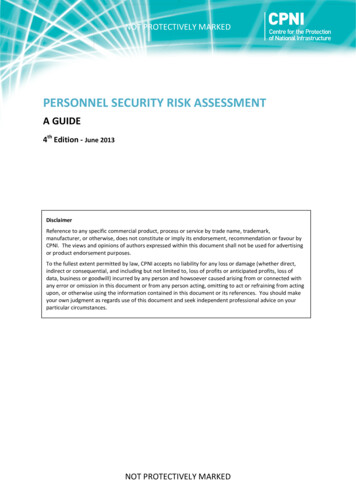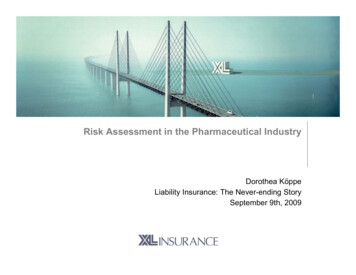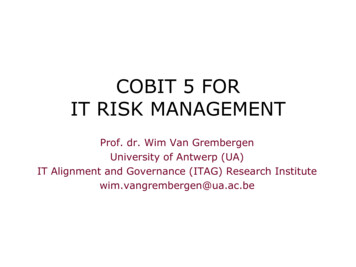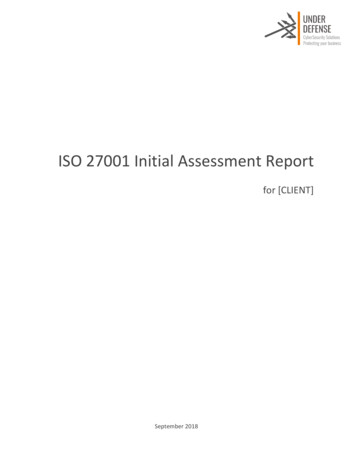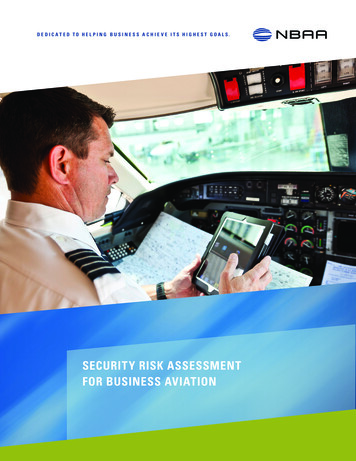
Transcription
D E D I C A T E D T O H E L P I N G B U S I N E S S A C H I E V E I T S H I G H E S T G O A L S.SECURITY RISK ASSESSMENTFOR BUSINESS AVIATION1 Risk Management Guide for Single-Pilot Light Business Aircraft
Table of ContentsIntroduction. 1Security Risk Assessment Process. 2Examples of Risk Assessment. 4Appendix 1: Security Risk Assessment Worksheet. 8Appendix 2: Security Risk Assessment Case Study #1. 9Appendix 3: Security Risk Assessment Case Study #2. 10Appendix 4: Additional Resources. 11IntroductionIn the post-9/11 world, aviation security has become the responsibility of individuals and organizations across the aviationindustry – from ground crews and schedulers, to pilots and business leaders, to government officials. As threats and threatactors evolve, continued enhancement of corporate aviation security is a critical component to national security. Across theaviation industry, standards for safety and security have traditionally been set by large governing bodies, including the USDepartment of Homeland Security, Transportation Safety Administration, the Federal Aviation Administration, the NationalTransportation Safety Board and the International Civil Aviation Organization. For the general aviation (GA) community – andparticularly business aviation – these standards must be viewed by corporate directors of aviation and security as a startingpoint for their aviation safety and security programs.The National Business Aviation Association (NBAA) supports the continued adoption, implementation and enhancement ofmany security requirements, programs and best practices that reduce business aviation’s vulnerability to terrorist threats. Riskassessments are a critical part of any organization’s security process. Proper risk assessment provides security teams with thenecessary data points to mitigate or accept any residual risk.This Security Risk Assessment process, developed and produced by the NBAA Security Council specifically for business aviation professionals, provides a simple product for assessing risk in a variety of business aviation-related areas. This assessmentdoes not require significant security training or background, making it a useful tool across any organization. The instructions andformat are designed to allow users from across an organization to be effective risk assessors with minimal additional training.This product is not designed to replace any other security procedure or process, but to serve as supporting effort to existingand growing risk assessment and mitigation processes. For questions or comments about this resource, please contact SarahWolf at swolf@nbaa.org.Security Risk Assessment for Business Aviation 1
Security Risk Assessment ProcessThe assessment process is intended to provide guidance for analyzing the risk levels associated with your future operations. Whileeach organization will have different approaches to quantifying risk to company assets, which include personnel, aircraft, productivity and public image, the general methodology for evaluating the security risk level is widely applicable: Identify, assess andmitigate. For the aviation department, make sure you are aware of your company’s major security risks domestically and abroad.The user should ask the following questions:1) Would a reasonable person in the same and similarsituation come to the same conclusions?3) Are the risk prevention and mitigation toolsadequate for my operation?2) Is this operation unique, or is there guidance fromother sources?4) Are industry best practices employed, both in theflight planning process and during the mission?Answering these questions thoroughly requires working knowledge (within your organization or through a third-party source) ofcurrent issues and pain points in the region or country that you are traveling to. For a list of resources to help keep you abreaston political, cultural and other relevant factors on the ground where you’re traveling, see Appendix 4: Additional Resources.Ultimately, risk determination is subjective and even the most stringent mitigation process cannot guarantee 100 percent security. Under some circumstances, the operation may have to go forward regardless of risks identified beforehand. However,by following this process you are ensuring preparedness for whatever may arise during the course of the mission.STEP 1: DETERMINE POTENTIAL RISKSThorough and precise evaluation of potential risk factors is paramount when assessing the overall risk level of an operation.As an example, consider the airport of arrival as the operational component and a specific vulnerability within that broadcategory, such as poor perimeter security where the aircraft will be parking, as the risk factor to be assessed.For some operations, the specific region in which the operation occurs will present risks. In this case, consider location asthe operational component and the potential for damages as a result of political unrest as the specific risk factor. Remember that risk is always present at some level. Additional risks may be present only when your operation arrives in the regionbecause someone is targeting your company or a specific person.Example: The next mission will be landing at an airport that has seen severalsecurity breaches over the last decade. As part of determining potential risks,your flight department analyzes these incidents for specific risk factors thatcould lead to a similar security breach while the aircraft is on the ground.STEP 2: DETERMINE RISK PROBABILITYThe probability of an identified risk affecting your operation should be based onseveral factors: historical data, current circumstances, and any unique factorsthat may heighten risk (e.g., CEO has received credible threats). The followingtable provides the metrics we’ll be using for this assessment.Risk Probability DescriptorsNear Certainty – An event is extremely likely to occurLikely – An event is more likely than not to occurUnlikely – An event is unlikely to occur but still possibleRemote – An event is highly unlikely to occurProbability of Operational ImpactRisk ValueDescription4Near Certainty3Likely2Unlikely1RemoteExample: Based on analysis of previous incidents and current conditions onthe ground, you decide there’s a likely chance that the identified risk factor willhave an operational impact. This is quantified as a “3” for the assessment.Security Risk Assessment for Business Aviation 2
STEP 3: DETERMINE RISK SEVERITYAfter determining the probability of a risk impacting your operation, you willwant to determine (using your company’s internal methodology) the potentialimpact of the risk using several categories. As an example, an organizationmay be most concerned with the potential impact on three categories:personnel safety, asset damage and interruption to business activity.Risk SeverityRisk gibleRisk Severity DescriptorsCatastrophic – Results in fatalities and/or total lossMajor – Results in severe injury and/or major damageMarginal – Results in minor injury and/or minor damageNegligible – Results in less than minor injury and/or damageExample: Previous incidents at this airport resulted in operational disruptionbut no significant damage to asset or personnel. As such, you decide the riskseverity is marginal and quantify that with a “2” for the assessment.STEP 4: DETERMINE OVERALL RISK LEVELThis chart provides an example of how companies may calculate overall risk level by multiplying the probability of a riskoccurring with the severity that risk entails. Keep in mind when flying into certain regions with higher risk factors, such asones with recent political, cultural or military turmoil, you may wish to factor that into the equation.For this assessment, there are five possible levels of overall risk:Critical (13 ): This level represents an unacceptable risk.Operations at this level shouldSTOP. This level is coded Black.Very High (10-12): The highestlevel of potentially acceptablerisk. Implementation of risk prevention and mitigation shouldoccur immediately. Operationsat this level should likely STOP.This level is coded RED.Risk Assessment MatrixSeverity of Potential RiskProbabilityCatastrophic (4)Major (3)Marginal (2)Negligible(1)Near Certainty (4)Critical (16)Very High (12)High (8)Medium (4)Likely (3)Very High (12)High (9)Medium (6)Low (3)Unlikely (2)High (8)Medium (6)Medium (4)Low (2)Remote (1)Medium (4)Low (3)Low (2)Low (1)High (7-9): This level is at theupper end of normal operational range. Implementation of risk prevention and mitigation should occur as soon as possible.Operations may continue at this level provided all team members are aware of the potential risk, and all team membersaccept the mitigated risk. This level is coded ORANGE.Medium (4-6): This level is within a normal operational range. Implementation of risk prevention and mitigation should occur as soon as practical. Each team member should conduct operations at an elevated level of consciousness. This level iscoded GREEN.Low (1-3): This is the lowest level of risk. Implementation of risk prevention and mitigation is at its lowest achievablelevel. Risks can usually be addressed by following best practices. This level is coded GREY.Example: Since you determined risk probability is 3 and risk severity is 2, youcalculate an overall risk level of 6 (Medium). For mission planning purposes,this means the airport represents a risk within normal operational range.Crew should conduct operations at an elevated level of consciousness.Security Risk Assessment for Business Aviation 3
Examples of Risk AssessmentCreated by NBAA and its Security Council, this reference table provides a look at common risks factors and potential mitigation strategies. While this is not a comprehensive review of all the risks your operation may face, it offers examples of howyour organization will want to analyze and develop mitigation strategies for potential risks.OperationalComponentRisk FactorRisk Observations/AssessmentsRisk Mitigation MethodsAirportLack of AirportSecurity Does the aircraft parking area have adequatelighting, and have you verified the lighting isoperational? Is the entire facility surrounded by a fenceof sufficient height and design? Is the fenceinspected regularly? What kind of access control is in place at theFBO/GA area? Are entry points manned orunmanned? Are the airport and GA areas open 24/7 andhow busy are the areas? What is the FAA IASA security rating for thelocation and what concerns are stipulated, ifany? Is there an active security committee and awritten security plan for the airport? Security ContractorsInternal Aircraft StorageAirport Analysis/AuditReposition AircraftAlternate ARR/DEP TimesExternal Aircraft Locksand EquipmentAircraftUnattendedAircraft (Overnight) Same as above Airport Lights24/7 FBO OperationsRamp SecurityAircraft LocksATCAircraft InterceptOver ForeignAirspace Has the crew been trained and made aware of ATC Emergency Communicathe procedures to follow?tion and Contacts Pre-Trip Crew Briefing Flight Following Procedures Embassies and ConsulatesATCDCA Access Is the crew DCA trained and licensed? Is an armed and licensed armed security officer (compliant with regulations) available forthe flight? CountryCivil/PoliticalUnrest Have passengers received and read through apre-trip intelligence briefing? Have any ongoing or potential protests ordemonstrations been reported that couldcoincide with the trip? Are there any upcoming dates of significancethat could trigger unrest? Are the itinerary and travel schedule plannedto avoid any known demonstrations or otherpotential targets for unrest, such as government or police stations? DCA Access TrainingBriefingChecklist UsageContingency Planning andGateways Armed Service Officer Briefing Firearm KnowledgeRegional AwarenessSecurity ContractorsEmergency Response PlanCultural Awareness TrainingRegional Security ContactsContingency PlanningSecurity Risk Assessment for Business Aviation 4
OperationalComponentRisk FactorRisk Observations/AssessmentsRisk Mitigation MethodsCrewOvernight inForeign Country Are your passport and essentials on yourperson at all times? Are you familiar with the broad outline of thecity and major landmark locations? Have you checked for any local customs/cultural highlights you should be aware of at bothbusiness and tourist levels? Do you have emergency communications andcontingencies planned? Do you know where other team members arelocated? Have you contacted your Embassy/Consulate? Cultural Awareness TrainingCrew PairingScheduled Crew Check-InsPre-Trip Crew BriefingEmbassy/Consulate ContactsSTEP RegistrationCrewIncapacitated/Missing Crew Do you know where the nearest quality emergency room is located and is it open 24/7? Do the staff speak English if international? Does your insurance provide coverage at thislocation? Do you know who to contact within yourorganization in case of injured/missing crew? Did you register with State Dept’s STEPprogram before departing? Who is your company contact in case ofemergency? Have you contacted your Embassy/Consulate? Cultural Awareness TrainingContingency PlanningLanguage FluencyCriminal ActivityAwareness TrainingCrewNatural Disaster/Emergency Who is your company contact in case ofemergency? Do you know where all of your team issupposed to be? Do you have an assigned rendezvous point incase communications are out? Do you know how to reach or contact yourEmbassy/Consulate? Can the crew get to the airport safely tosecure the aircraft? Emergency Response Plan Communication Regional DisasterAwareness TrainingCrewIdentification asCrew Members Do you have guidelines for traveling safely inhigher threat/crime locations? Have you considered securing ID and namebadges or flight charts out of sight? Are you able/permitted to change or usecasual outerwear to cover uniforms whenoutside the airport? Have you secured jewelry, watches and othervaluables out of sight before leaving the airport, or preferably before leaving home? Limit Use of PersonalIdentification Secure Valuables Cultural Blending and Customs ApparelCrewComplacency Do you have a checklist for pre-trip planning? How/when are security and safety addressedin the pre-planning effort? Has the crew been provided an overview(intelligence briefing) of conditions and basictravel knowledge of the destinations involved? Do you have a means to get incident alertsduring a trip that could impact safety/security? Flight Planning ProvidersAdvocacy GroupsIntelligence BriefingsInternational NOTAMSProactive Outreach to Embassy/ConsulateSecurity Risk Assessment for Business Aviation 5
OperationalComponentRisk FactorRisk Observations/AssessmentsRisk Mitigation MethodsCrewUncontrolledBaggage How is luggage handled within the airportperimeter? Is luggage screened and secured within theairport grounds prior to loading? Do you have a reliable bag identification andretrieval process in place? Does the airport have the necessary equipmentto screen baggage prior to getting it on the aircraft? (X-ray machines, body scanning, dogs, etc.) HAZMAT Awareness Training Positive BagIdentification Control Controlled Loading Baggage Screening/Monitoring Passenger Luggage BriefingFBOCatering Does the catering provider have on-site foodpreparation? What is the reputation of the caterer? Does the caterer use locally sourcedfood/ingredients? Does the caterer have required local licensing andcertifications and are they posted and available? Tamper-Proof Containers/Equipment Food Handling Training Catering Control Measures Vetting CaterersFBORamp Control Are any overt signs of security rampchallenges known or detected? Do private vehicles have access to the ramp? How is ramp access controlled/monitored? Are badges visible? Proper badge securityenforced? Is access to active ramp areas controlledby card? Is there a security plan in place for the FBO? Security Identification DisplayArea Badging Dedicated Security Personnel Airport Watch ProgramITCybersecurity Have the passengers been briefed onessentials of cybersecurity? Have passengers been trained on passwordsecurity best practices? Have specific concerns with high-risk destinations (e.g., China, Russia) been addressed? Do you have a company policy addressingcybersecurity and use of electronic devices? What methods are in place for passengersto reduce risk in connecting to an unknowninternet source? Have aircraft systems been evaluated forvulnerability to cyber attacks? LodgingHotel Have you reviewed hotel location and access toAccommodationsmain roads? Is it possible to get in/out easily? Does the hotel have cleared access to andwithin stairwells, as well as unblocked emergency exit doors? Are the common areas organized and clearedof clutter and people during normal operations? Are sprinkler systems visible and fire extinguishers present in common areas, hallways,rooms, etc.? Is the front desk staffed 24/7 and are the staffvisible and reachable by phone? Does hotel have restricted access after-hours?If so, does this restricted access include outerdoors and elevators? Does hotel offer necessary amenities to limitneed for additional travel?Cybersecurity TrainingHardware Protective DevicesSecurity ProtocolsSoftware Vetting and EncryptionStrong Passwords Room SecurityAwareness Training Personal Security Measures Establish CrewCommunication Plan Awareness Briefing Contingency Plan Crew Amenities Availableat HotelSecurity Risk Assessment for Business Aviation 6
OperationalComponentRisk FactorRisk Observations/AssessmentsRisk Mitigation MethodsLodgingRoom Access Does each room have a visible and clearlymarked emergency exit plan? Were you supplied with properly working keys? Does the hotel have audit capability on doorreaders if needed for post-incident assessment? Does each room have multiple door latches/bolts? Is the room’s door or windows/porch accessible from the ground or any nearby structures? Do the front desk personnel engage in properetiquette/confidentiality of room numbers? MaintenanceThird-PartyVendors Do primary and secondary vendors haveinsurance/licensing to support risks fromthird-party vendors? To what standards are all elements of thevendor chain held responsible? Are regular checks/inspections carried outincluding background checks of personnelwith access to the aircraft and sterile area? How often, if ever, are the vendors audited forperformance and service level? Are “secret shopper”-type inspectionsconducted for each vendor? Assigned Duties Packaging Awareness Training Material Safety Data SheetTraining and Safety EquipmentScheduling &DispatchingDemonstrations/Special Events/Holidays Have you checked your itinerary againstpossible conflicts like holidays, parades,demonstrations, sporting events or otherlocal events? TransportGeneral GroundTransportation Are details about vehicle and driver providedin advance? Are these details visually confirmed onsite before getting in the vehicle? Does the driver ask for your photo identification to confirm identity of his passenger(s)? Are you monitoring driver distractions andchecking that the driver is following directroutes (using GPS)? Have you ensured rear door child locks aredisengaged before entering the vehicle? Are you keeping your luggage/valuables inactive sight and secured? Have you ensured driver knows your itineraryin advance, preferably when booking? Vetting Contractors Confirm Positive ID of Driverand Vehicle Routing Best Practices Establish Emergency Contactsand Contact with EmbassyAwareness TrainingCase StudiesEmbassy/Consulate ContactsContingency PlanningPre-Trip Crew BriefingAlternate AccommodationsContingency PlanEmergency Response PlanSecurity Risk Assessment for Business Aviation 7
Appendix 1: Security Risk Assessment WorksheetBased on the process detailed in the Security Risk Assessment for Business Aviation resource, this worksheet offers a simple on-the-go tool for gauging potential security risks. As you plan your mission, use the charts below to guide your thoughtprocess as you analyze risks to the operation. Additional worksheet pages are available at nbaa.org/security.Formula for Computing Risk Level of an Operational Component1. Determine risk probabilityBased on historical trends and currentfactors, find the probability closest toyour analysis on this chart and use thatnumber for your calculations.2. Determine risk severityBased on your organization’s assets and operational needs, findthe risk description that best matches your internal data anduse that number for your calculations.Probability of Operational ImpactRisk SeverityRisk ValueDescriptionRisk ValueDescription4Near Certainty4Catastrophic (Results in fatalities and/or total loss)3Likely3Major (Results in severe injury and/or major damage)2Unlikely2Marginal (Results in minor injury and/or minor damage)1Remote1Negligible (Results in less than minor injury and/or damage)3. Determineoverall risk levelMultiply both numberstogether to arrive atthe overall risk level forthis operational component. Combine thiswith your organization’stolerance for risk todetermine if mitigationmethods are needed.OperationalComponentSpecific RiskRisk Assessment MatrixSeverity of Potential RiskProbabilityCatastrophic (4)Major (3)Marginal (2)Negligible(1)Near Certainty (4)Critical (16)Very High (12)High (8)Medium (4)Likely (3)Very High (12)High (9)Medium (6)Low (3)Unlikely (2)High (8)Medium (6)Medium (4)Low (2)Remote (1)Medium (4)Low (3)Low (2)Low (1)RiskSeverityRiskProbabilityRisk Rating(Combined)Risk Observations/AssessmentsSecurity Risk Assessment for Business Aviation 8
Appendix 2: Security Risk Assessment Case Study #1International Airport ExampleThis airport is the primary international airport in the country. Built for military purposes originally, this airport hostsapproximately 20 million passengers a year. The airport itself as well as the surrounding perimeter has very tightsecurity and is one of the safest airports to operate into and out of in the world. Border police soldiers accompanyuniformed and ununiformed security officers.There is a high level of threat severity. There is a higher risk of terrorist attacks in urban areas of this country. Thecity this airport is located in, like most cities around the world is, for the most part, a safe area to travel to and be in.Areas of random violence and conflict continue to provide threat of civil unrest, however.The crew will be housed at a worldwide hotel chain, between the city and the airport. All crew members will be at thesame hotel. Transportation from the airport to the hotel is provided by a vetted operator through coordination with theFBO. The crew will only be staying at the hotel for one night, and will not have sufficient time for personal exploration ofthe local area.Operational Security Risk AssessmentOperationalComponentSpecific RiskRiskSeverityRiskProbabilityRisk Rating(Combined)AircraftUnattended Aircraft (Overnight)313 (Low)ATCAircraft Intercept OverForeign Airspace428 (High) ATC Emergency Communication and ContactsCountryCivil/Political Unrest428 (High) Regional AwarenessCrewOvernight in Foreign Country224 (Medium)CrewIncapacitated/Missing Crew428 (High) Embassy/Consulate ContactsCrewNatural Disaster/Emergency428 (High) Regional Disaster AwarenessTrainingCrewIdentification as Crew Members(Off-Airport)224 (Medium)ITCybersecurity313 (Low)LodgingHotel Accommodations32 Personal Security Measures6 (Medium) Crew Amenities Available atHotelLodgingRoom Access212 (Low)Scheduling &DispatchingDemonstrations/Special Events/Holidays3412 (VeryHigh)TransportGeneral Ground Transportation326 (Medium)Risk Observations/Mitigations Alternate Accommodations Emergency Response PlanSecurity Risk Assessment for Business Aviation 9
Appendix 3: Security Risk Assessment Case Study #2Domestic Airport ExampleThis is the city’s second largest commercial and general aviation airport, located approximately 7 miles south of downtown. The airport services four commercial airlines totaling more than 13 million passengers annually. The airport operates with standard security measures in place for both the commercial terminal and the FBOs inside the perimeter.There is a medium level of threat severity in the city and in the area immediately around this airport, primarily due tothe risk of crime. There is no specific risk of terrorism related to this location other than exists as background concerns in most major aviation facilities. Within this large city, wealthy and disadvantaged areas are often in closeproximity to each other, which can present inadvertent exposure to crime and related threats for those unfamiliarwith traveling through the city. Taxis and ride-share services, along with nearby hotel shuttles, are relatively safe,though caution with unknown drivers should always be exercised.On this flight, there is a contract flight attendant. The three crewmembers will be housed in a hotel near the airportand will not be renting a car. Transportation from the FBO is provided by a ride-share service. The hotel does nothave a restaurant in it but there are number of options within the surrounding area, some that can be walked to easilyfrom the hotel. The crew will be at the hotel for two nights.Operational Security Risk AssessmentOperationalComponentSpecific RiskRiskSeverityRiskProbabilityTotal RiskRatingAirportLack of Airport Security212 (Low)AircraftUnattended Aircraft (Overnight)212 (Low)CrewIncapacitated/Missing Crew339 (High)CrewNatural Disaster/Emergency414 (Medium)CrewIdentification as Crew Members (Off-Airport)326 (Medium)CrewInadequate Pre-Trip Planning224 (Medium)CrewUncontrolled Baggage313 (Low)FBOCatering212 (Low)ITCybersecurity212 (Low)LodgingRoom Access224 (Medium)Maintenance Third-Party Vendors224 (Medium)Transport224 (Medium)General Ground TransportationRisk Observations/Mitigations Internal Aircraft Storage Criminal ActivityAwareness Training Limit Use of Personal Identification Secure Valuables Positive Bag Identification Control Contingency Planning Confirm Positive ID of Driver andVehicleSecurity Risk Assessment for Business Aviation 10
Appendix 4: Additional Resources US State Department Travel veladvisories/traveladvisories.html Smart Traveler Enrollment Program (STEP)https://step.state.gov/step/ OSAC Crime and Safety Reportshttps://www.osac.gov/Pages/Home.aspx ATA Travel Information aspx Individual state Aeronautical Information Publications (AIPs)www.eurocontrol.int/articles/ais-online IATA Travel Centrewww.iatatravelcentre.com US Customs and Border Protectionwww.cbp.gov/travel NBAA’s List of Flight Planning and Flight Support rvices/fpsp/ The CIA World Fact tbook/ The Centers for Disease Controlwww.cdc.gov International Business Aviation Council (IBAC)www.ibac.org NBAA Professional Development Courseswww.nbaa.org/pdp Australian Foreign Travel Informationwww.smartraveller.gov.au/ British Foreign Travel Advicewww.gov.uk/foreign-travel-advice Canadian Foreign Travel Advicewww.travel.gc.ca/travelling/advisories Additional Travel Registration Programs:Australia: https://www.orao.dfat.gov.auCanada: rance: ublic/login.htmlIreland: https://citizensregistration.dfa.ie/Mexico: https://sirme.sre.gob.mx/New Zealand: GMENTSThe National Business Aviation Association wishes tothank the members of its Security Council for theirwork developing this resource.ABOUT NBA AFounded in 1947 and based in Washington, DC, theNational Business Aviation Association (NBAA) is theleading organization for companies that rely on generalaviation aircraft to help make their businesses moreefficient, productive and successful. Contact NBAA at800-FYI-NBAA or info@nbaa.org. Not a member?Join today by visiting www.nbaa.org/join.Security Risk Assessment for Business Aviation 11
In the post-9/11 world, aviation security has become the responsibility of individuals and organizations across the aviation industry – from ground crews and schedulers, to pilots and business leaders, to government officials. . cur as soon as practical. Each team member should conduct o




